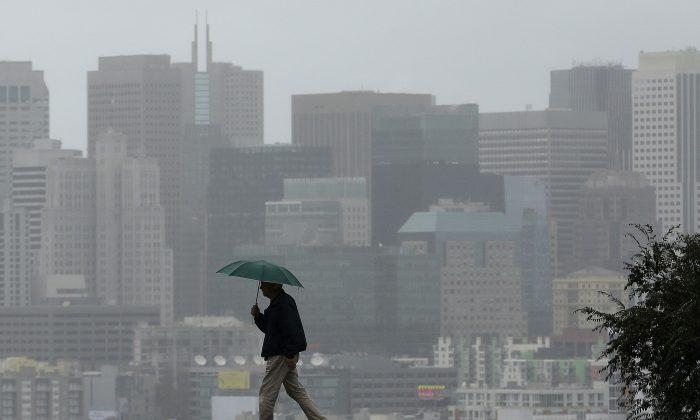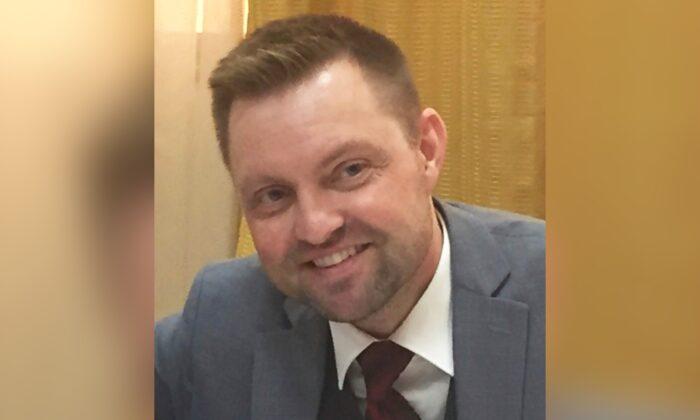SAN FRANCISCO—Californians who have sharply reduced water use during their four-year drought were warned against reverting to old habits Tuesday, Jan. 5, as the first of several storms spawned by a record-tying El Niño began drenching the state.
The series of storms lining up over the Pacific Ocean was welcome news in California, despite their potential for causing flash floods and mudslides.
But authorities cautioned that even the wettest of winters can’t replenish depleted reservoirs and aquifers unless everyone keeps pitching in.
California’s water deficit is so deep that a “steady parade of storms” like these will be needed for years to come, said Mike Anderson, climatologist for the state’s Department of Water Resources.

“We’re at least on a good trajectory,” he said. “We’ve got to keep it going.”
The current El Niño—a natural warming of the central Pacific Ocean that interacts with the atmosphere and changes weather worldwide—has tied 1997-1998 as the strongest on record, the National Oceanic and Atmospheric Administration’s Climate Prediction Center said Tuesday, citing statistics that go back to 1950.
El Niños usually bring heavy rains to California, although it remains to be seen whether people should expect anything like a repeat of 1997 and 1998, when storms killed 17 people, wiped out crops, washed out highways, and pushed houses down hillsides.
“DarthNiño may finally have California in its sights,” said Jeff Masters, meteorology director of the private Weather Underground.
“A parade of strong Pacific storms characteristic of a strong El Niño event will batter the state this week and will likely bring damaging flooding by the time the second storm in the series rolls through on Wednesday,” Masters said.
However, Masters doesn’t believe this first storm is as powerful as some other Pacific storm systems, and caution that the storms now following it may land elsewhere.
The current forecast calls for as much as 15 inches of rain could fall in the next 16 days in Northern California, with about 2 feet of snow expected in the highest points of the Sierra Nevada, said Johnny Powell, a forecaster with the National Weather Service.
In Southern California, between 2 and 3.5 inches of rain is predicted to fall across the coastal and valley areas, and up to 5 inches falling in the mountains.
The first in the line of storms also drenched the desert Southwest on Tuesday and was aiming for the Gulf Coast, but should weaken to no more than a couple inches of rainfall by the time it reaches the Southeast, Masters added.
Preparations and Evacuations
In California, flash flooding and flows of mud and debris were a concern, especially in places left barren by last year’s wildfires. Residents of the Silverado Canyon burn area in Orange County and the Solimar burn area in Ventura County were urged to consider evacuating.
“The best time to prepare is before a weather event happens, but there is still time to prepare at least a basic emergency kit for your home, your car, or your place of work,” said Brad Alexander, spokesman for the Governor’s Office of Emergency Services.
Rocks fell on the roadway through Malibu Canyon, damaging four vehicles and clogging a heavily traveled commuter route through the steep Santa Monica Mountains, and Los Angeles police were rousting the homeless from normally dry riverbeds.
As steady and sometimes heavy rains fell, Los Angeles Mayor Eric Garcetti urged people to clear gutters and anything in their yards that might clog storm drains, and to stockpile sandbags if their home is susceptible to flooding.
Garcetti also said that the city’s homeless encampments have been mapped for the first time, and promised shuttles to bring people to shelters with 6,000 beds.
Los Angeles Fire Chief Ralph Terrazas said swift-water rescue teams are ready, but he'd rather not deploy them. Authorities hope to avoid a repeat of last September’s rescue of a homeless man who scrambled up a tree with his dog when the Los Angeles River quickly grew to a torrent.
The storms have whipped up large ocean swells that could generate hazardous breaking waves at west-facing harbors. Ventura’s Harbor Boulevard was closed Tuesday by flooding about a foot deep, police there said.
Altogether, the storms hold the potential for massive amounts of precipitation for a very parched state, but water managers won’t be able to fully estimate this year’s snowmelt until April 1, when the snowpack is typically at its deepest.
Californians used 20 percent less water this past November than they did in November 2013, before Gov. Jerry Brown declared the state’s water emergency, the Water Resources Control Board announced Tuesday.
That falls short of Brown’s 25 percent conservation mandate for a second straight month, although board chairwoman Felicia Marcus said the state remains on track to meet his overall goal.
“The fact that per person water use dropped to 75 gallons per person per day on average is proof that Californians are clearly thinking twice before turning on the tap,” Marcus said in a statement.
Despite these storms, Shawn Coburn says growers like him, working thousands of acres in the western San Joaquin Valley, expect no water this year from the federal government’s vast system of reservoirs and canals. He blames strict environmental laws designed to protect endangered fish.
“The people that run the system are telling us to be prepared for zero,” he said.





